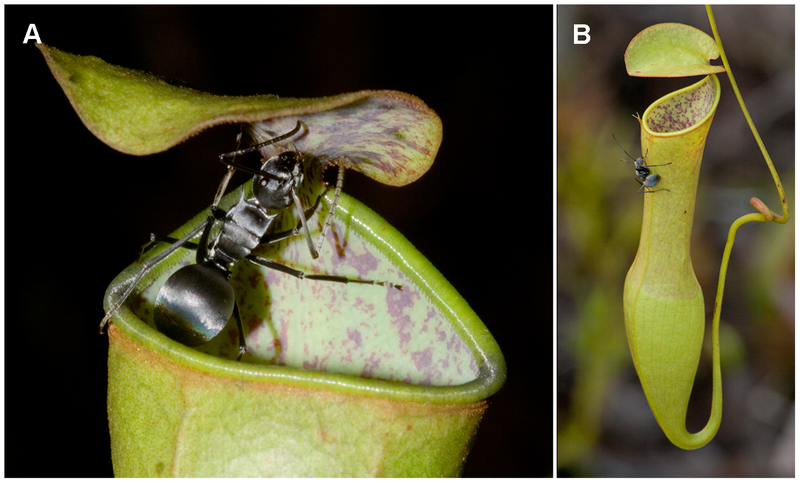
From Pitcher Plant Uses Rain Drops to Capture Prey (ScienceDaily, June 13, 2012), we learn,
… researchers have now discovered a new, unique method of capturing insects by the pitcher plant Nepenthes gracilis.
The lead author of the paper, Dr Ulrike Bauer from the University of Cambridge’s Department of Plant Sciences, said: “It all started with the observation of a beetle seeking shelter under a N. gracilis lid during a tropical rainstorm. Instead of finding a safe — and dry — place to rest, the beetle ended up in the pitcher fluid, captured by the plant. We had observed ants crawling under the lid without difficulty many times before, so we assumed that the rain played a role, maybe causing the lid to vibrate and ‘catapulting’ the beetle into the trap, similar to the springboard at a swimming pool.”
To test their hypothesis, the scientists simulated ‘rain’ with a hospital drip and recorded its effect on a captive colony of ants that was foraging on the nectar under the lid. They counted the number of ants that fell from the lid in relation to the total number of visitors. They found that ants were safe before and directly after the ‘rain’, but when the drip was switched on about 40% of the ants got trapped.
Further research revealed that the lower lid surface of the N. gracilis pitcher is covered with highly specialised wax crystals. This structure seems to provide just the right level of slipperiness to enable insects to walk on the surface under ‘calm’ conditions but lose their footing when the lid is disturbed (in most cases, by rain drops). The scientists also found that the lid of N. gracilis secretes larger amounts of attractive nectar than that of other pitcher plants, presumably to take advantage of this unique mechanism.
Seriously, Darwin’s banished co-theorist Wallace warned him to address the issue of carnivorous plants, but of course Darwin never did.
Note: We had quite the lark here last year when a carnivorous plant offered to eat a Darwinist. The Darwinist argued that carnivory must have evolved according to Darwin’s theory, but the plants maintain that they have always had a primordial right to eat whatever they trap, including even mammals, including Darwinists, without reference to Darwin’s theory. They prefer Black Forest ham and escargot, but settle for what falls in:
Carnivorous plants eat Darwinists
Carnivorous plants: After eating Darwin, they couldn’t resist furtherculinary adventures
Carnivorous plants: Darwinist Nick Matzke is latest to put Darwin’s theory “outside science”
Update from botanist on the plants that ate Darwin